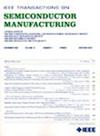相邻凸角各向异性刻蚀补偿结构的创新设计
IF 2.3
3区 工程技术
Q2 ENGINEERING, ELECTRICAL & ELECTRONIC
引用次数: 0
摘要
而深蚀刻硅形成各种微观结构与老板或交叉分割槽与v型或梯形截面,蚀刻溶液将削弱凸角。补偿结构设计的主要问题是凸角周围的空间要求很大。本文提出了一种补偿模式来补偿交叉劈裂槽相邻凸角的下切。在每个芯片的凸角处设置四个方形掩模。四个方形掩模的十二个凸角由六个定向的夹紧梁连接。在蚀刻的第一阶段,蚀刻溶液从两侧而不是从两端削弱定向夹紧梁。在80°C 25% TMAH溶液中,窄箝位-箝位梁的横向下切率仅为(100)平面蚀刻率的9.6%。这大大减小了四个相邻凸角之间补偿图案的尺寸。方形掩模用于在无掩模刻蚀夹紧梁下的硅楔时保护每个芯片的凸角不被蚀刻。这种凸角补偿模式减小了劈裂槽的宽度,提高了成品率。本文章由计算机程序翻译,如有差异,请以英文原文为准。
Innovative Design of a Compensation Structure for Anisotropic Etching of Adjacent Convex Corners
While deeply etching silicon to form various microstructures with bosses or crossing splitting grooves with a V-shaped or trapezoidal cross section, the etching solution will undercut convex corners. The major problem associated with compensation structure design is the large spatial requirement around the convex corners. This paper proposes a compensation pattern to compensate the undercutting of adjacent convex corners of crossing splitting grooves. Four square masks are set at the convex corners of each chip. The twelve convex corners of four square masks are connected by six <110> oriented clamped-clamped beams. In the first stage of etching, the etching solution undercuts <110> oriented clamped-clamped beams from both sides instead of from both ends. The lateral undercutting rate of the narrow clamped-clamped beams is only 9.6% of the etching rate of the (100) plane in 80°C 25% TMAH solution. This greatly reducing the size of compensation pattern between four adjacent convex corners. Square masks are used to protect the convex corners of each chip from being etched during maskless etching the silicon wedges under clamped-clamped beams. This convex corner compensation pattern reduces the width of splitting grooves and improves the yield.
求助全文
通过发布文献求助,成功后即可免费获取论文全文。
去求助
来源期刊

IEEE Transactions on Semiconductor Manufacturing
工程技术-工程:电子与电气
CiteScore
5.20
自引率
11.10%
发文量
101
审稿时长
3.3 months
期刊介绍:
The IEEE Transactions on Semiconductor Manufacturing addresses the challenging problems of manufacturing complex microelectronic components, especially very large scale integrated circuits (VLSI). Manufacturing these products requires precision micropatterning, precise control of materials properties, ultraclean work environments, and complex interactions of chemical, physical, electrical and mechanical processes.
 求助内容:
求助内容: 应助结果提醒方式:
应助结果提醒方式:


